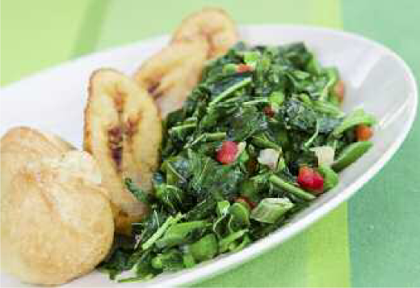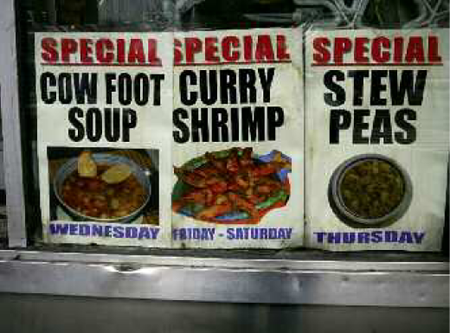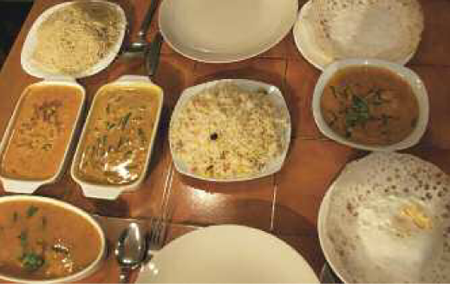4
The Indian Diaspora:
The Caribbean, Mauritius,
Sri Lanka and Fiji

She pack up all her curry and she runaway
Leaving me to worry myself sick each day,
I went and rome, from dust to dawn
Come back home to find the curry gone.
Mighty Trini, Curry Tabanca
While the British brought curry to their English-speaking colonies, it was Indians themselves who took their eating habits to the rest of the empire. In the nineteenth century, the vast subcontinent, ravaged by disease, famine and poverty, was fertile territory for recruiting soldiers for British armies and agricultural workers for the empire’s sugar, palm oil, coffee and tea plantations.
The abolition of the slave trade in the British Empire in 1807 and of slavery itself in 1833 created a labour shortage in Fiji, Mauritius, Trinidad and Tobago, Guyana, Malaysia and South Africa, since former slaves no longer wanted to perform back-breaking plantation work. So the British government set up offices in Calcutta and Madras to recruit Indians as indentured labourers to work for a certain period of time, typically five or ten years. They received basic provisions and a minimal salary, followed by either a free passage home or free land. All but a handful chose the latter option.
Between 1834, when the first group of indentured labourers arrived in Mauritius, and 1917, when the system was abolished, nearly 1.5 million Indians emigrated to other parts of the British Empire. In the western hemisphere, 240,000 Indians went to British Guiana (now Guyana), 144,000 to Trinidad and 36,000 to Jamaica. Around 150,000 labourers migrated to South Africa. Others went to Fiji and Malaysia. Most of the immigrants came from either north and central India – the present-day states of Bihar, Orissa and Uttar Pradesh – or Tamil Nadu and Andhra Pradesh in the south.
The British authorities also made arrangements with the French and Dutch to send indentured workers to their colonies. Between 1853 and 1885, eighty thousand Indians migrated to Martinique, Guadeloupe and French Guyana. A smaller group went to Dutch Guyana, now Surinam, where they became known as Hindoestanen. When Surinam gained its independence in 1975, many migrated to the Netherlands.
Trinidad and Tobago
Over 40 per cent of the one million inhabitants of Trinidad and Tobago are of Indian origin; another 40 per cent are AfroTrinidadian; while the remaining 20 per cent are of Chinese, European and Middle Eastern descent. Although Trinidadian cuisine combines elements of all these backgrounds, curry and other Indian dishes have become symbols of national identity and feature in popular Calypso and Soca songs.
Most Indo-Trinidadians came from north-east and central India and spoke a language called Bhojpuri. These origins explain certain features of Indo-Trinidadian food. For example, whole wheat flour is never used in Trinidadian breads (rotis) as it is in India, because wheat was not grown in the immigrants’ home regions and the first flour they encountered would have been imported white flour. A pinch of baking powder is always added to these breads. Phulorie, sahenna, kurma and other fried savoury snacks are similar to those found in the immigrants’ ancestral regions. The basic ingredients of a typical Trinidadian spice mixture – cumin, coriander, fenugreek and turmeric – are what would be used in a peasant household here.
Bandhaniya or shadow beni is a local herb used as a substitute for coriander in Trinidadian cuisine. |
Callaloo refers both to the leaf of the dasheen plant (a form of taro) and to a popular Jamaican and Trinidadian stew.
On their arrival, immigrants received daily rations of rice, dal, coconut oil or ghee, sugar and salt, turmeric and sometimes salted or dried fish and onions. Substitution was essential, since ingredients such as curry leaves, fresh coriander and mint were not grown locally. The substitute for coriander is a local herb called shado(w) beni that grows wild in drainage ditches. The chilli pepper used in Trinidadian curries is the very fiery scotch bonnet, so-called because it looks like a little pleated bonnet. In place of the spinach-like greens called ‘sag’ in India, Trinidadians and Jamaicans use callaloo, the leaf of the dasheen plant (a form of taro). Callaloo is also the name of a soup cooked with coconut milk, crab, okra, chillies and herbs.
In a typical Trinidadian curry the meat (usually chicken or goat) or fish is first marinated in garlic, onion, chillies, shadow beni and ‘seasonings’ – a tied bundle of chopped chive, parsley, shadow beni and garlic purchased in the market. The cook browns the onions and garlic in oil, sautés a paste of curry powder mixed with a little water (a distinctive Caribbean technique) and adds the meat and marinade. At the end a little roasted cumin powder, a typical Trinidadian spice, is sprinkled to impart aroma. Sometimes a little local rum is added.
A roadside stand in Trinidad advertises its daily specials.
A characteristic feature of Trinidadian curries is the use of a ready-made curry powder, which gives them a certain consistency of flavour. The best-known manufacturers are Turban Brands, founded by a Sikh in 1956, and Chief, which is somewhat ‘hotter’. However, ‘authentic’ Indian food also has a certain cachet and home cooks grind their own spice mixtures on special occasions.
Curries are accompanied by chutneys and sauces, including mango kuchela, a mango and mustard oil pickle, and ‘mother-in-law’, a fiery vegetable relish. Rotis are used both to scoop up the curry and as a wrapper to hold a filling.
In Trinidad, the word ‘roti’ also refers to a popular street food that has been known as the country’s national dish. A large thick roti coated with ground yellow peas is wrapped around a meat, fish or vegetable curry, enclosed in wax paper or foil and eaten on the move. Another popular street food is ‘doubles’, a sandwich composed of two pieces of turmericflavoured fried roti filled with curried chickpeas and topped with spicy chutneys and chilli sauce. It is very similar to the Indian snack chole bhature.
Other distinctive Trinidadian breads are ‘buss-up-shut’ roti (named after a ‘bursted-up shirt’), a flaky roti torn into ragged pieces; dal puri roti, fried bread stuffed with spiced lentils; sada roti, a plain white bread often made at home; and oil roti, a flaky paratha.
Guyana
In Guyana (formerly British Guyana), a small country in the north-east corner of South America, 43 per cent of the population are of Indian origin. The cuisine is similar to that of Trinidad and Tobago. Curries, a common main course, are usually served with rotis made from white flour and accompanied by relishes and pickles. The standard cooking liquid is coconut milk. Hotness comes from wiri wiri, a small local fragrant and fiery locally grown chilli. Although Guyanese curries are generally fiercely hot, some people also eat spicy pickles as a condiment or even take a bite out of a fresh chilli with each mouthful. Tartness comes from tomato, tamarind or green mango.
Fish curries are very popular in Guyana, especially when made from the freshwater fish that live in irrigation canals and rivers. Vegetables are often added to curries; popular combinations include chicken and squash, duck and potato, mutton and aubergine, shrimp and pumpkin, green beans and dried fish, and crab and aubergine. Vegetables that were originally grown in temperate climates, such as cauliflower, peas and carrots, did not become part of the culinary tradition as they did in India.
Jamaica
Although people of Indian origin constitute only 3 per cent of Jamaica’s population, traditional Indian foods such as ‘curry goat’, roti and callaloo are now seen as ‘Jamaican’. (Jamaicans sometimes name their food for the cooking technique: curry goat, stew chicken, jerk pork, steam fish and so on.) The national dish is saltfish (salted cod) and ackee (a tropical fruit) made with black pepper and scotch bonnet peppers. Curry goat, served on festive occasions, is cooked with prepared curry powder and scotch bonnet chillies in coconut milk and often served with rice and peas (kidney beans or pigeon peas). A soup called ‘mannish water’ containing a goat’s head and other parts (including the penis), tomatoes, vegetables and chillies is believed to have aphrodisiac powers and is traditionally served to grooms on their wedding night.
A local twist is given to the classic British oxtail stew by the addition of beans, allspice (known locally as pimento) and scotch bonnet peppers. Beef patties, spiced ground meat in a dough pocket similar to an empanada, are popular snacks not only in Jamaica but also in Toronto and other North American cities with a large Caribbean population.
A spicy oxtail stew made with beans is a Jamaican version of a classic British dish.
Mauritius
An island nation in the Indian Ocean 500 miles east of Madagascar and 3,000 miles from India, Mauritius is a linguistic and culinary melting pot. Two-thirds of the population are of Indian origin (52 per cent Hindus, 13 per cent Muslims), 30 per cent are Franco-Mauritian or creoles and 3 per cent Chinese. Although the official language is English, most people speak a French-based Creole. Mauritius was colonized by the Dutch from 1598 to 1715, by the French from 1715 to 1815 and by the British from 1815 to 1968. Starting in the 1830s, the British brought in nearly half a million indentured labourers, mainly from north-eastern India, to work on the sugar plantations.
Mauritian cuisine is an intriguing mixture of African, Dutch, French and Indian ingredients and techniques. A curry may be made with octopus, or combine venison and lilva beans (a slightly sweet and bitter bean popular in western India), or chicken and prawns. Vindaille (a word related to vindaloo) is prepared by marinating fresh tuna, octopus or other seafood in mustard, saffron, chillies, garlic, oil and vinegar. A popular Indian-Mauritian snack is dalpuri – bread filled with curried lentils, rougaille (a spicy tomato-based sauce), chutneys and vegetable pickle.
Those who like to speculate about what Indian cuisine would have been like had the French conquered India instead of the British need only look at the sophisticated cuisine of Mauritius. An excellent collection of hundreds of recipes can be found at www.ile-maurice.tripod.com.
Sri Lanka
Sri Lanka, a small island in the Indian Ocean (until 1972 called Ceylon), is home to a society with a rich colonial past and a cuisine that is a mosaic of Sinhalese, Tamil, Indian, Dutch, Portuguese, Malay and British influences.
As a producer of spices and a stopover for ships plying the spice routes, in ancient times Sri Lanka was visited by merchants from the Middle East, Persia and South-east Asia. The Portuguese arrived in 1505 but were expelled by the Dutch in 1653; they in turn lost the island to the British in 1792. Ten years later, Ceylon became a British crown colony. In the nineteenth century, the British established tea, cinnamon, rubber, sugar, coffee and indigo plantations on the island and brought in thousands of indentured labourers from Tamil Nadu to work on them.
More than 80 per cent of Sri Lanka’s population are Sinhalese, their ancestors having come from northern India thousands of years ago; they are mainly Buddhists. Around 10 per cent are Hindu Tamils. Sri Lanka also has small minorities of Muslims, who can trace their lineage to Arabs and Indians; Malays, brought by the Dutch; and Burghers – people of mixed European (especially Dutch) and Sinhalese or Tamil descent. In recent decades, many Burghers have emigrated to Australia, Canada and Britain, taking their eating habits with them.
The classic Sri Lanka cookbook, The Ceylon Daily News Cookery Book (first published in 1929 and still used today) by Hilda Deutrom, herself a Burgher, illustrates this diversity. It has separate chapters on British and Anglo-Indian dishes (for example, mulligatawny soup and kedgeree); rice and curries; sambals; chutneys and pickles; Sinhalese recipes; Tamil recipes; Sinhalese and Tamil sweets; Dutch and Portuguese sweets; and ‘short eats’ – a vivid local term for hors d’oeuvres and afternoon snacks.
Rice is the staple served with curries, boiled or made into two distinctive local products: hoppers, disc-shaped sautéed breads made of fermented rice flour and coconut milk, and string hoppers, steamed thin vermicelli. Both Tamil and Sing-halese cuisines make extensive use of tamarind, Maldive fish (dried fermented bonito), coconut milk and fresh coconut. In Anglo-Indian recipe books, a Ceylon curry usually meant a seafood or fish curry with a coconut gravy.
A typical Sri Lankan curry powder is similar to the ones used in southern India and contains coriander, fennel, cumin, fenugreek, curry leaves, dried coconut, mustard seeds and chillies. Aromatic spices such as cinnamon and cardamom are added to Muslim meat-based dishes. Singhalese curries are classified by colour: white curries are milder with a more subtle flavour; black curries are made with spices roasted to create a deep, rich flavour; and red curries are made with plenty of red chillies. Like some South-east Asian curries, they often include lemon grass and pandanus (screwpine) leaves.
A Sri Lankan meal features such dishes as fish curry, green beans, mango pickle, egg and string hoppers (rice noodles).
One of the most famous Sri Lankan Burgher culinary creations is lamprais (also spelled lampries and pronounced ‘lampreese’), a kind of mini-rijsttafel. Its components are small mounds of ghee rice (rice sautéed in ghee and aromatic spices before boiling), an elaborate curry made from four meats, an ash gourd or banana curry, balanchan, chilli and onion sambal, and frikkadels (spicy meatballs of Dutch origin). All these items are wrapped in a steamed or roasted banana leaf to make a parcel that is held together by ekels – ribs of a coconut palm leaf. The parcels are warmed in the oven and brought to the table on a platter. Each guest receives at least one and unwraps it, savouring the aroma of spices and the fragrance of the banana leaf. The correct composition of a lamprais is the subject of heated dispute among Sri Lankans, especially those living abroad who have fond memories of the dish from their childhood.
Fiji
Nearly half of the population of Fiji, an island nation in the south Pacific, are descendants of 60,000 Indians brought by the British in the late 1890s to work on the sugar plantations. Fijian cuisine is a melange of Melanesian, Polynesian, Indian, Chinese and Western elements. Fijian curries are made with breadfruit, yam, cassava, taro root and leaves, and seafood, and usually contain coconut milk. Flavourings include garlic, ginger, turmeric, coriander, fenugreek, cumin, soy sauce and chillies. An unusual home-style curry is ‘tinned fish’ curry, made with canned tuna, mackerel or salmon. From Fiji, curries and curry powder spread to Tonga, Samoa and other islands in the Pacific, where they are often served with boiled taro or breadfruit as the starch.




